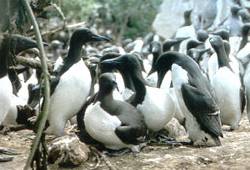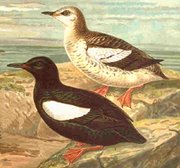Auk
|
|
| Auks | ||||||||||
|---|---|---|---|---|---|---|---|---|---|---|
 Common and Thick-billed Murres | ||||||||||
| Scientific classification | ||||||||||
| ||||||||||
| Genera | ||||||||||
|
Alle |
Auks are birds of the family Alcidae in the order Charadriiformes. They are superficially similar to penguins due to their black-and-white colours, their upright posture and some of their habits. Nevertheless they are not related to the penguins at all, but considered by some to be a product of moderate convergent evolution. (They are sometimes humorously cited as the explanation why penguins do not exist in the Northern Hemisphere.)
In contrast to penguins, auks are able to fly (with the exception of the extinct Great Auk). They are good swimmers and divers, but their walking appears clumsy. Due to their short wings auks have to flap their wings very fast in order to fly.
Auks live on the open sea. Only for breeding do they go ashore, although some species, like the Common Guillemot, spend a great part of the year defending their nesting spot from others.
Several species have different names in Europe and North America. The guillemots of Europe are murres in North America, if they occur in both continents, and the Little Auk becomes the Dovekie.
Some species, such as the Uria guillemots nest in large colonies on cliff edges,others, like the Cepphus guillemots breed in small groups on rocky coasts, and the puffins, auklets and some murrelets nest in burrows. All species except the Brachyramphus murrelets are colonial.
| Contents |
Evolution and distribution
The earliest fossil auks are from the Miocene, 15 MYA, although some fossils from the Eocene (25 MYA) have tentitavely been placed as alcids. Miocene fossils have been found in both California and Maryland, but the greater diversity of fossils and tribes in the Pacific leads most scientists to conclude that it was there they first evolved, and it is in the Miocene Pacific that the first fossils of extant genera are found. Early movement between the Pacific and the Atlantic probably happened to the south (since there was no northern opening to the Atlantic), later movements across the Arctic Sea. The extant auks are broken up into 2 main groups, the puffins (subfamily Fraterculini) and auklets (subfamiliy Aethiini), and the Uria guillemots (subfamily Alcini), murrelets and guillemots (subfamilies Cepphini and Brachyrampphini). Compared to other families of seabirds, there are no genera with many species (such as the genus Larus in the gulls, which has 47 species). This is probably a product of the limited range of the family (the most limited of any seabird family), and the periods of glacial advance and retreat that has kept the populations on the move.
Today, as in the past, the auks are restricted to cooler northern waters. Their ability to spread further south is restricted as their prey hunting method, pursuit diving, becomes less efficient in warmer waters. The speed at which small fish (which along with krill are the auk's principal food items) can swim doubles as the temperature increases from 5°C to 15°C, with no corresponding increase in speed for the bird. The southernmost auks, in California and Mexico, can survive there because of cold upwellings. The current paucity of auks in the Atlantic (6 species), compared to the Pacific (19-20 species) is considered to be because of extinctions to the Atlantic auks, the fossil records shows there were many more species in the Atlantic during the Pliocene. Auks also tend to be restricted to continental shelf waters and breed on few oceanic islands.
Feeding and ecology
The feeding behaviour of auks is often compared to that of penguins, they are both wing-propelled pursuit divers. In the region where auks live their only seabird competition is with cormorants (which dive powered by their strong feet); in areas where the two groups feed on the same prey the auks tend to feed further offshore.
Although not to the extent of penguins, auks have to a large extent sacrficed flight, and also mobility on land, in exchange for swimming; their wings are a compromise between the best possible design for diving and the bare minimum needed for flying. This varies by subfamily, the Uria guillemots (including the Razorbill) and murrelets being the most efficient under the water, whereas the puffins and auklets are better adapted for flying and walking. This reflects the type of prey taken, murres hunt faster schooling fish, whereas auklets take slower moving krill. Time depth recorders on auks have shown that they can dive as deep as 100 m in the case of Uria guillemots, 40 m for the Cepphus guillemots and between 30 m for the auklets.
Social behaviour and breeding
The majority of auk species are colonial, nesting in anything between small groups to large thousand strong colonies. As well as possible advantages for defence against predators, there is a benefit in terms of foraging to being colonial; birds that see a neighbour returning with food will set off to forage in the direction it came in. Two species, the Marbled Murrelet and the Kittlitz's Murrelet are solitary nesters, choosing old growth forest and high mountains respectively. In these areas the benefits of colonial nesting would be outweighed by the presence of terrestrial predators (foxes and raccoons, for example) which island and cliff breeding auks do not have to deal with.
Nesting sites in colonies can vary from nothing more than a patch on a cliff face, to natural crevices in the rocks and boulders, to burrows dug by the bird. Many nesting sites are attended nocturnally, in some cases as the adults are likely to fall victim to kleptoparasitism (such as the Rhinoceros Auklet) or because the adults themselves are likely prey items (like the Cassin's Auklet). breeding itself can happen both on the colony, as happens with the Razorbill and Little Auk, or at sea, as the puffins and auklets do.
Species
- Order Charadriiformes
- Suborder Charadrii: The waders
- Suborder Lari. gulls, terns, skuas and skimmers
- Suborder Alcae
- Family Alcidae
- Little Auk or Dovekie, Alle alle
- Common Murre or Common Guillemot, Uria aalge
- Thick-billed Murre or Brunnich's Guillemot, Uria lomvia
- Razorbill, Alca torda
- Great Auk, Pinguinus impennis (extinct)
- Black Guillemot or Tystie, Cepphus grylle
- Pigeon Guillemot, Cepphus columba
- Spectacled Guillemot, Cepphus carbo
- Marbled Murrelet, Brachyramphus marmoratus
- Kittlitz's Murrelet, Brachyramphus brevirostris
- Xantus's Murrelet, Synthliboramphus hypoleucus
- Craveri's Murrelet, Synthliboramphus craveri
- Ancient Murrelet, Synthliboramphus antiquus
- Japanese Murrelet, Synthliboramphus wumizusume
- Cassin's Auklet, Ptychoramphus aleuticus
- Parakeet Auklet, Cyclorrhynchus psittacula
- Crested Auklet, Aethia cristatella
- Whiskered Auklet, Aethia pygmaea
- Least Auklet, Aethia pusilla
- Rhinoceros Auklet, Cerorhinca monocerata
- Atlantic Puffin, Fratercula arctica
- Horned Puffin, Fratercula corniculata
- Tufted Puffin, Fratercula cirrhata
- Family Alcidae
ThickbilledMurre23.jpg

References
Gaston, Anthony; Jones, Ian, The Auks, Alcidae, (1998), Oxford University Press, ISBN 0-19-854032-9eo:Aŭkedoj fr:Pingouin fy:Alkfûgels it:Alcidae lt:Alkiniai paukčiai nl:Alkachtigen
